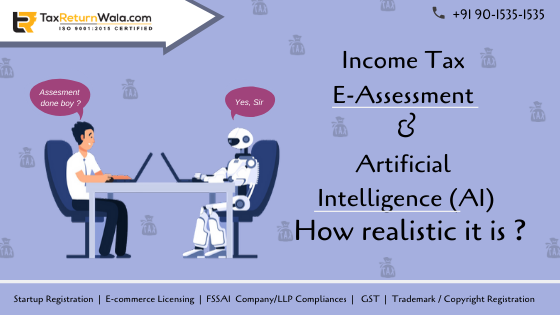Income Tax E-Assessment and Artificial Intelligence how realistic it is?
After moving ahead from paper return to paperless return starting from 2012 for specified taxpayers to a more broad list of taxpayers by whom only the return through e-filing portal that is paperless return is mandatory to vide notification issued in July 2018.
The Central Board of Direct Taxes (“CBDT”) on 12th, September 2019 announced and notified another round of shift in the technology for assessment of tax returns online. With an AI-driven scheme namely ‘E-assessment Scheme 2019’ of the tax department, the government has now initiated for speedier processing of tax e-returns online rather than keeping it to multiple – lagging stages of manual assessment.
The new scheme will replace the current system of manual assessment of tax returns by officers. The model scheme for E-assessment of Income Tax Returns was first presented in 2018 as an optional mode for assessment of returns. The notified scheme will make use of Artificial Intelligence (AI) to randomly select tax returns for scrutiny by the officers and bring more transparency in operations.
Salient Features of the Scheme
- Single Point of Contact:
With this e-assessment scheme, the assessee would not be required to move around tax offices for submitting the requested scrutiny information or in the response to notices(except in some special cases), the taxpayer will be issued a notice through a common assessment portal which is also accessible through a mobile app. The app or the portal will update in real-time the progress of the case with department i.e., the response submitted to the notice, the action on response submitted, etc.– The single point of contact is also for communications between the different units and center inter –se.
- Use of AI:
The e-assessment process will be technology-driven with the use of data analytics, machine learning, and artificial intelligence and all compact tools for determining misreporting or evasion of tax rules.
- 3. Composition of Work Units:
The new E-assessment scheme 2019 will hold the following work units for feasibility in the assessment of returns:
- National E-assessment Centre (NEC):
These units are responsible for assuring coordinated work culture between other units. It will be allowed to issue notice, call for explanations, demand information from the taxpayer. The taxpayer will receive a digitally signed notice from the unit which is accessible through a mobile application or sent over email for which the taxpayer is required to respond within 15 days from the date of issue of notice.
The National e-assessment Centre will be a communication link between the taxpayer and other work units vis a vis amongst the center and units inter-se. It provides a centralized platform to communicate back and forth, removes direct communication with concerned tax officials to negotiate.
The regional e-assessment center is authorized with the powers and functions to facilitate the assessment under certain defined jurisdictional e-assessment proceedings.
The Principal Chief Commissioner is vested with jurisdictional powers for e-assessment.
- Assessment and Verification units:
These units are responsible for handling individual scrutiny and assessment cases, allocated through a digital allocation system. It shall also prepare DAO (Draft Assessment Order) and will send it to NEC for review. The Verification units (VU) will ensure the recording of assessee’s statements, evidence verification, conducting cross-examinations, inquiries wherever required.
- Technical and Reviewer Units :
The technical units will provide advice on legal issues, data analytics, technical matters, transfer pricing, forensic, accounting required for assessments and Reviewer units will check for DAO(Draft assessment orders) for assuring authenticity of evidence presented, case laws, check for relevant points in the scrutiny cases and arithmetic accuracy in functions.
Each regional e-assessment center shall have their technical and review units.
- Legal support:
The scheme has been further supported by adding Sections 3A to 3C of Information Technology Act, 2002 (known as “IT Act,2002”) under Section 143 (3) of Income Tax Act, 1961 ensuring all e-assessment proceedings in a digital mode, prompting for negligible errors in-laws and proceedings.
Step by Step Procedure in E-Assessment Scheme, 2019
- National e-assessment center (‘NEC’) will send a digitally signed copy of the tax notice to the assessee for which he’ll be alerted through a real-time email or SMS.
- NEC will update on the case to the appropriate Assessment Unit (“AU”) for seeking further clarification and resources for assessment from the taxpayer.
- Based on the information provided by the taxpayer, the AU will prepare a DAO and will send it to NEC for review. For demand or penalty to be added, the AU will issue DAO to the taxpayer with demand where applicable.
- On receipt of the response of show cause notice or DAO from the taxpayer, the NEC will decide for AU to proceed or draft a revised DAO to the taxpayer.
- The NEC shall provide a chance to the asses-see to present his case. On completion of the assessment, records, as prepared and gained, it will get transferred to the Jurisdictional Assessing officer (JAO) for appealing for a penalty, recovery of demand or initiating further proceedings of the case.
- During such an assessment, any unit can place an additional penalty over the assessee for reason specified and may demand the NEC to serve another notice to assessee. The actual presence of the assessee is not be required during the proceedings. While in some exceptional cases, he might be called or proceedings can be done through video conferencing.
The use of the ‘E-assessment Scheme 2019’, is notified from the date of its publication i.e.,12th September 2019 and the overall concept has been praised by the industry as a keen step towards standardization, facilitating transparency and easing of tax procedures.
You might require tax planning in the coming assessment period!
Feel free to consult our tax experts online at info@taxreturnwala.com
Also Read: Missed Income tax return for 2017-18 or earlier period? What to do now?


